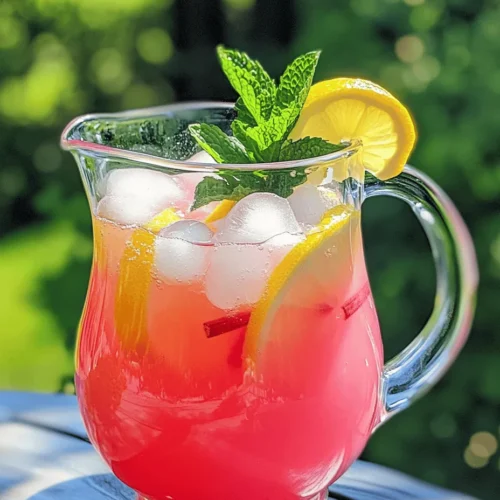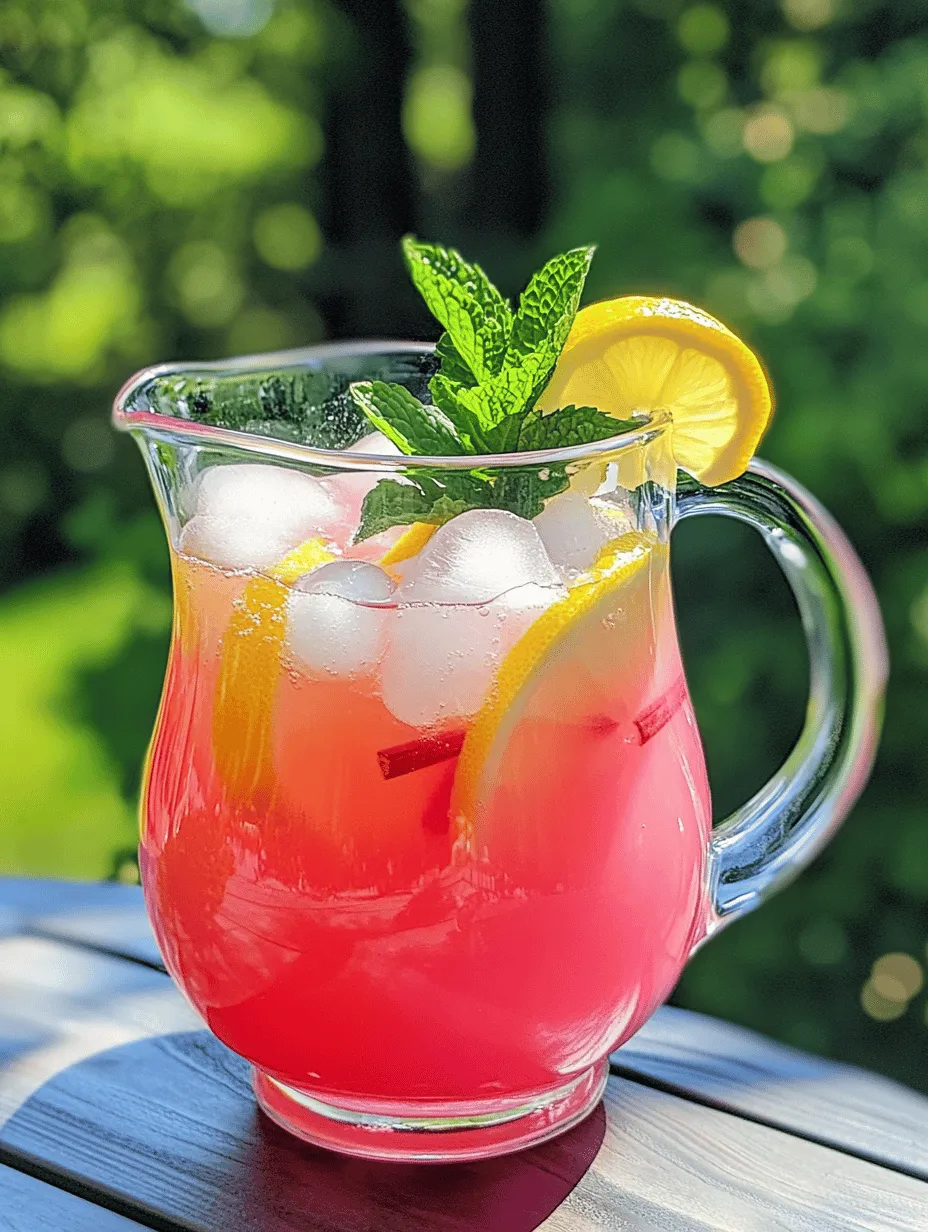Introduction
As the warm sun begins to shine and summer beckons, there’s nothing quite like a refreshing glass of lemonade to quench your thirst. However, while traditional lemonade has its charm, introducing rhubarb into the mix elevates this classic beverage with a unique flavor that is both tangy and sweet. Rhubarb, often mistaken for a fruit, is actually a vegetable that boasts a tart flavor profile, making it an excellent ingredient for brightening up drinks and desserts alike.
Rhubarb lemonade is not just a delightful twist on the classic recipe; it also brings with it a host of health benefits. Rich in vitamins, minerals, and fiber, rhubarb can contribute to a refreshing drink that not only tastes great but also supports your health during the hot summer months. In this article, we will delve into the vibrant world of rhubarb lemonade, providing you with a detailed recipe and insights about rhubarb, its uses, and the historical significance of lemonade as a summer staple.
Understanding Rhubarb
Rhubarb (Rheum rhabarbarum) is a perennial plant characterized by its thick, fleshy stalks and large, leafy tops. The stalks are what we consume, often used in a variety of culinary applications, from pies to sauces and, of course, beverages. The flavor of rhubarb is distinctively tart, which makes it an excellent companion for sweeter ingredients like sugar or honey, balancing out its natural acidity.
Nutritionally, rhubarb is low in calories yet rich in dietary fiber, which aids in digestion, and packed with vitamins K and C, as well as important minerals such as calcium and potassium. This nutrient profile makes rhubarb a fantastic addition to your diet, especially in a refreshing drink like lemonade.
Historically, rhubarb has been used in cooking for centuries. Originally native to Asia, it made its way to Europe and became popular in various dishes, particularly in desserts. Its use in beverages has gained traction in recent years, with rhubarb lemonade emerging as a trendy option for those seeking a refreshing twist on a classic drink.
When it comes to selecting rhubarb, freshness is key. Look for firm stalks that are vibrant in color—deep red or bright green are both good indicators of quality. Avoid any stalks that appear wilted, limp, or discolored. Seasonal availability typically peaks in the spring and early summer, making this the ideal time to experiment with rhubarb in your culinary endeavors.
Lemonade: A Classic Refreshment
Lemonade has a storied history, dating back to ancient Egypt, where a drink made from lemon juice, sugar, and water was enjoyed by the nobility. Over the years, lemonade has evolved into a quintessential summer refreshment, synonymous with picnics, barbecues, and lazy afternoons spent under the sun. Its bright, citrusy flavor is invigorating, and it remains a favorite for both children and adults alike.
As lemonade has become a staple of summer traditions, various adaptations have emerged, ranging from lavender-infused versions to berry-flavored twists. Among these variations, rhubarb lemonade stands out for its unique flavor profile and vibrant pink hue, making it not only delicious but also visually appealing.
The health benefits of lemon juice are well-documented. Rich in vitamin C, lemon juice supports the immune system and promotes hydration, making it an ideal base for a refreshing drink. By combining lemon juice with rhubarb, you create a beverage that is not only tasty but also packed with antioxidants and essential nutrients.
Ingredients Breakdown
To make this refreshing rhubarb lemonade, you’ll need a few simple ingredients. Each component plays a crucial role in achieving the perfect balance of flavors. Here’s a breakdown of what you’ll need:
1. Fresh Rhubarb: The star of this recipe, fresh rhubarb provides the tartness that defines the drink. When preparing rhubarb, start by removing the leaves, as they are toxic. The stalks should be washed thoroughly, and then chopped into smaller pieces for easy cooking.
2. Sugar: This ingredient is essential for sweetening the lemonade and balancing the tartness of the rhubarb. You can adjust the amount of sugar according to your taste preferences. For those looking for alternatives, consider using honey, agave syrup, or a sugar substitute to accommodate dietary needs.
3. Water: Water is the base of any lemonade. For the best flavor, it’s advisable to use filtered water. This ensures that any impurities or chlorine from tap water don’t affect the taste of your refreshing drink.
4. Lemon Juice: Freshly squeezed lemon juice is crucial for achieving the zesty flavor characteristic of lemonade. It’s best to avoid bottled lemon juice, as it often contains preservatives that can alter the flavor.
5. Optional Garnishes: For an extra touch, consider adding fresh mint leaves or lemon slices as garnishes. These not only enhance the visual appeal of your drink but also add a refreshing aroma that complements the flavors.
In the next part of this article, we will walk through the step-by-step instructions on how to prepare this delightful rhubarb lemonade, ensuring that you can easily replicate it at home for your summer gatherings.

Freshly Squeezed Lemon Juice: Benefits of Using Fresh Versus Bottled
When it comes to making the perfect rhubarb lemonade, the choice between freshly squeezed lemon juice and bottled lemon juice can significantly affect the flavor and overall quality of your drink. Freshly squeezed lemon juice boasts a vibrant taste that is hard to replicate with bottled varieties. It contains essential oils from the lemon peel, which contribute to a more aromatic and flavorful experience. Additionally, fresh lemon juice is free from preservatives and additives commonly found in bottled versions. This means you not only enjoy a fresher, more natural flavor but also benefit from the higher nutritional value. Fresh lemons are rich in vitamin C and antioxidants, which can boost your immune system and enhance your overall health.
Using fresh lemon juice in your rhubarb lemonade ensures that every sip is bursting with zesty goodness. When you squeeze lemons at home, you can also control the level of tartness, allowing you to adjust the acidity to your liking. This simple ingredient choice elevates your lemonade from a basic drink to a refreshing delight that captures the essence of summer.
Optional Garnishes: Mint Leaves and Lemon Slices for Presentation and Flavor Enhancement
Garnishes can elevate the presentation and taste of your rhubarb lemonade, making it not just a drink but a delightful centerpiece for your table. Fresh mint leaves are an excellent garnish that adds a pop of color and a refreshing aroma. Simply pluck a few mint leaves and gently slap them between your hands to release their essential oils before placing them on top of your lemonade. This simple technique enhances the drink’s fragrance and adds a subtle minty flavor that pairs beautifully with the tartness of rhubarb and the citrusy zing of lemon.
Lemon slices are another fantastic garnish that adds visual appeal. Thinly slice a lemon and place a slice on the rim of your glass or float a slice in the lemonade itself. This not only enhances the drink’s aesthetic but also infuses the lemonade with additional lemon flavor as it sits. For an extra touch, consider adding a sprig of fresh mint alongside the lemon slice for a vibrant and inviting presentation that will impress your guests.
Step-by-Step Instructions
Preparing the Rhubarb Syrup: Boiling and Steeping Methods
To begin crafting your refreshing rhubarb lemonade, the first step is to prepare the rhubarb syrup. Start by washing and chopping 2 cups of fresh rhubarb into small pieces, about 1-inch long. In a medium saucepan, combine the chopped rhubarb with 1 cup of water and 1 cup of granulated sugar.
Boiling Method: Place the saucepan on medium heat and bring the mixture to a gentle boil. Once boiling, reduce the heat and let it simmer uncovered for about 10-15 minutes, or until the rhubarb is soft and has broken down. Stir occasionally to ensure the sugar dissolves completely.
Steeping Method: If you prefer a more delicate flavor, you can also steep the rhubarb. Combine the chopped rhubarb, sugar, and water in the saucepan, then bring to a boil. Once boiling, remove the saucepan from heat and cover it. Let the mixture steep for 30 minutes to an hour, allowing the rhubarb to infuse its flavor into the syrup without cooking it down too much.
Straining the Mixture: Tips for Maximizing Liquid Extraction
Once your rhubarb syrup is ready, it’s time to strain it to separate the liquid from the solids. Place a fine mesh strainer or cheesecloth over a bowl or large measuring cup. Carefully pour the rhubarb mixture into the strainer, allowing the syrup to flow through. Use the back of a spoon or a spatula to press down on the solids to extract as much liquid as possible. This step is crucial to obtain a smooth, flavorful syrup without any gritty bits from the rhubarb.
Discard the solids or repurpose them in other recipes, such as a rhubarb compote or as a topping for yogurt or oatmeal. You should be left with a beautiful, vibrant pink syrup that will form the base of your lemonade.
Mixing and Adjusting Flavors: How to Achieve the Perfect Balance of Sweetness and Tartness
Now that you have your rhubarb syrup, it’s time to mix it with freshly squeezed lemon juice. In a large pitcher, combine 1 cup of the rhubarb syrup with 1 cup of freshly squeezed lemon juice. Add 4 cups of cold water to dilute the mixture, adjusting to your taste preference. Stir well to combine all the ingredients.
This is the perfect time to taste your lemonade. If you find it too sweet, add more lemon juice to increase the tartness. Conversely, if the lemonade is too tart, you can stir in a bit more rhubarb syrup or sugar until you achieve your desired flavor profile. Remember, the balance between sweetness and tartness is key to a refreshing lemonade.
Chilling and Serving: Presentation Ideas for a Refreshing Drink
Once your rhubarb lemonade is mixed to perfection, it’s time to chill it. Refrigerate the lemonade for at least 1-2 hours before serving, allowing the flavors to meld and the drink to become refreshingly cold.
When ready to serve, fill glasses with ice and pour in the chilled rhubarb lemonade. For a beautiful presentation, consider using clear glassware that showcases the vibrant pink hue of the drink. Garnish each glass with a slice of lemon and a few mint leaves for a pop of color and elegance. If desired, you can also rim the glasses with sugar for an extra sweet touch. This simple addition enhances not only the visual appeal but also the overall drinking experience.
Serving Suggestions
Ideal Occasions for Serving Rhubarb Lemonade
Rhubarb lemonade is a versatile drink that fits perfectly into various occasions. It is an ideal beverage for summer picnics, barbecues, and outdoor gatherings where guests can enjoy a refreshing drink while socializing in the sunshine. Its unique flavor profile makes it a hit at birthday parties, bridal showers, or any festive event where a refreshing beverage is needed.
Additionally, rhubarb lemonade can be served alongside meals as a delightful non-alcoholic option. Its tartness complements savory dishes, making it an excellent choice for lunch or dinner parties.
Pairing Options: Complementary Foods that Enhance the Lemonade Experience
When serving rhubarb lemonade, consider pairing it with complementary foods that enhance the experience. Light summer salads, grilled chicken, or seafood dishes work exceptionally well with the tartness of the drink. For a sweet pairing, serve it alongside light desserts such as fruit tarts, lemon bars, or shortcakes. The refreshing nature of the lemonade balances the richness of these dishes, creating a harmonious meal.
Creative Presentation Ideas: Using Unique Glassware, Garnishes, and Serving Styles
To elevate your serving experience, think creatively about your glassware and presentation style. Use mason jars for a rustic touch, or opt for elegant stemware for a more formal gathering. You can also serve the lemonade in a large glass pitcher with a spout for self-serving options, allowing guests to refill their glasses at their leisure.
Enhance the visual appeal by adding seasonal fruits to the pitcher, such as sliced strawberries, raspberries, or even cucumber slices, which not only look stunning but also infuse additional flavors into the lemonade.
Exploring Variations of Rhubarb Lemonade
Suggestions for Flavor Variations: Adding Other Fruits or Herbs
While the classic rhubarb lemonade is delightful on its own, you can easily experiment with flavor variations to keep things interesting. Consider adding other fruits such as strawberries, blueberries, or even peaches to the mix. Simply muddle the fruits in the bottom of your glass or pitcher before adding the lemonade for a fruity twist.
Herbs like basil or thyme can also lend a unique flavor to your rhubarb lemonade. Add a few fresh leaves while mixing, or steep them in hot water for a few minutes with the rhubarb syrup to create an herb-infused lemonade that is refreshing and aromatic.
Alcoholic Versions: Transforming the Lemonade into a Refreshing Cocktail
For those looking to turn this refreshing beverage into a cocktail, consider adding your favorite spirit. Gin, vodka, or rum can all make excellent additions to rhubarb lemonade. Start by mixing the lemonade with 1-2 ounces of your chosen spirit in a glass filled with ice. Stir gently to combine and adjust the sweetness to your preference.
You can also create a layered cocktail by pouring the rhubarb lemonade over the spirit slowly, allowing the colors to create a beautiful gradient effect. Garnish with fresh fruits or herbs to enhance the visual appeal and flavor.
Sugar Substitutes: Crafting a Low-Sugar or Sugar-Free Lemonade Option
If you’re looking for a healthier option, consider using sugar substitutes in your rhubarb lemonade. Natural sweeteners like stevia, agave syrup, or honey can replace granulated sugar for a lower-calorie version. Alternatively, you can use a sugar-free sweetener that is suitable for your dietary needs.
Experiment with the amount of substitute to achieve the perfect sweetness, as some may vary in potency compared to traditional sugar. This way, you can enjoy a refreshing rhubarb lemonade without the guilt.
Conclusion
Making and enjoying rhubarb lemonade is a delightful experience that combines the vibrant flavors of fresh ingredients with the joy of crafting a refreshing beverage. From the process of creating the rhubarb syrup to experimenting with garnishes, every step is a chance to engage with seasonal ingredients and bring a taste of summer to your table.
Whether you serve it at a picnic, a summer barbecue, or simply enjoy it on a warm afternoon, rhubarb lemonade can easily become a staple in your warm-weather repertoire. Don’t hesitate to experiment with different flavors and variations to make the recipe your own. The joy of creating refreshing beverages using seasonal ingredients is an experience worth savoring. So grab your fresh rhubarb and lemons, and start crafting a pitcher of this delightful lemonade that is sure to impress family and friends alike.



